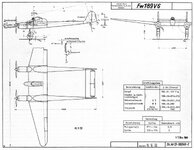A member on another forum posted some interesting diagrams of the Ta-154. What I'm interested in is the wing profile used, that looks like it had it's thickest part close to the 40% of the chord, at least judging by this picture.
Any volunteers to try to decipher what kind of airfoil was used there?
Any volunteers to try to decipher what kind of airfoil was used there?



